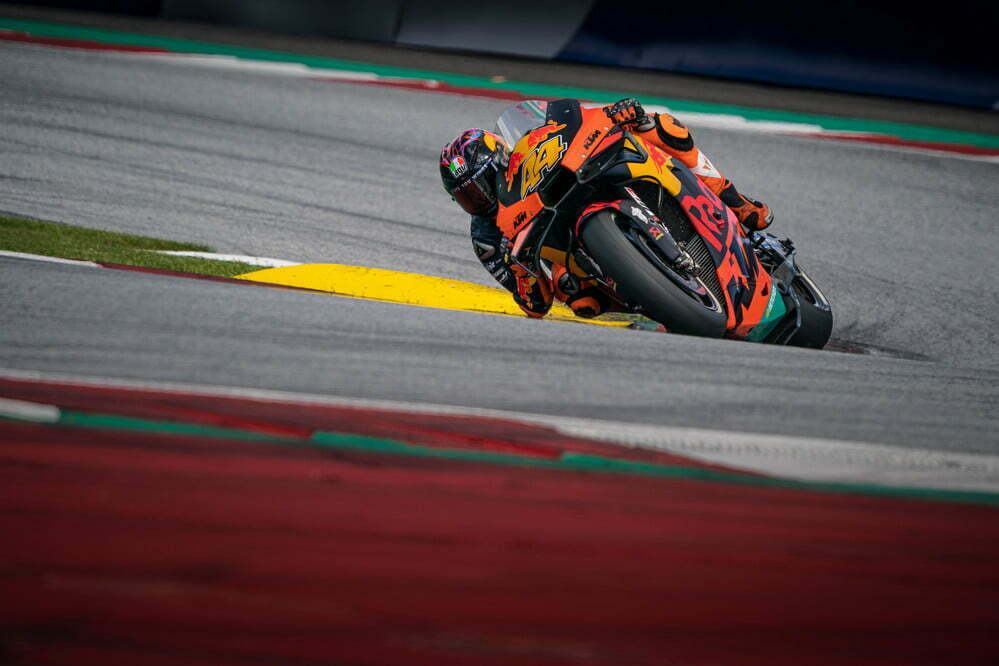
MotoGP: Can KTM Dethrone Ducati in Austria?
One week on from KTM’s first win in MotoGP, the World Championship heads to the RedBull Ring for the Austrian brand’s home race.
Brad Binder’s victory one week ago in Brno was a stunning upset that shifted the balance of MotoGP and confirmed a fifth race-winning factory. Not only was Binder’s personal performance in piloting the RC16 to that win spectacular, but so has been the progress of the motorcycle from 2019 to 2020.
Last season, a top six would have been a fantastic result for KTM in the dry, their only realistic hope of a podium finish being if the track was wet, as proven by Johann Zarco’s front row start in the 2019 Czech Grand Prix. However, if KTM finish with one bike in the top six and none on the podium this weekend in Austria, especially because it is a circuit where they have tested extensively, it would be a significant disappointment. Fortunately for the Mattighofen marque, their bike is suited well to the Red Bull Ring.

Having been through several rebrandings, the modern Red Bull Ring still maintains one of the main characteristics of its predecessors: speed. Although less flowing than the layouts from which it is derived, the Red Bull Ring has the highest average speed on the MotoGP calendar, with Marc Marquez’ pole lap from 2019 clocking a 187.2km/h average.
As such, it is not surprising that the Austrian Grand Prix has been won by Ducati each year since it returned to the calendar in 2016.
Ducati, though, are currently in a peculiar moment. Johann Zarco finished third in the Czech Grand Prix last weekend on his 2019 edition Desmosedici, but the factory riders, with the GP20, suffered across the weekend. Jack Miller was the top GP20 rider, finishing ninth, whilst the two riders of the factory team, Andrea Dovizioso and Danilo Petrucci, finished 11th and 12th respectively.
The critical change for Ducati appears to be the 2020 rear Michelin tyre. Historically, the Ducati likes to run minimal lean angle, less than its competitors, in the middle of the corner, and to run its maximum angle for as little time as possible. To do that successfully, its riders slide the bike into the corner, turning with the rear and making use of engine braking and especially the rear brake, and then on corner exit using the throttle to rotate the bike. Doing this, they have been able to somewhat mask the lacklustre handling capabilities of the Ducati at maximum angle.
Michelin’s 2020 tyre makes it more difficult to do this, since it offers more grip than the old tyre, which already overwhelmed the Michelin front. As a result, the bike understeers more, meaning the rider has to wait longer to get back to the throttle – and, of course, the throttle is Ducati’s most potent weapon.
Additionally, the 2020 Michelin seems to produce more grip on the edge of the tyre, helping the likes of Yamaha and Suzuki, the inline-four motorcycles that like to run high corner speed but suffer for power compared to their V4 rivals. Since Ducati don’t like to use the edge of the tyre, they are suffering now that the inline-four riders can find traction as well as durability from the edge of the tyre.

Perhaps, then, it will be good for Ducati to come to a track where they traditionally dominate and race there twice. It could mean two (relatively) straightforward wins – Marc Marquez remains absent, don’t forget – and the repetition of the Red Bull Ring could allow them understand things that they wouldn’t get to look at in a normal race weekend, as Valentino Rossi in the Jerez double header a few weeks ago.
However, given the recent, substantial troubles for Dovizioso, Miller and Petrucci in another of Ducati’s more recently favoured circuits – Brno – and the absence of Francesco Bagnaia, it could be that Zarco is the Bologna brand’s best option for victory this weekend, and to continue their unbeaten run in Austria.
It is also worth pointing out that Zarco traditionally goes well in the Red Bull Ring. He won the Moto2 race in 2016, and finished fifth in the 2017 MotoGP race on the Tech 3 Yamaha.
If Zarco were to take his first MotoGP win this weekend, though, it seems certain he will have to overcome the bike he left last year, the RC16.
Whilst Ducati have lost their advantage with the new Michelin, KTM appear to have gotten stronger. It looks like KTM are able to use the edge of the tyre better than Ducati, as the RC16’s chassis responds better at maximum angle, but also find good drive grip on the shoulder of the tyre. Combined with the strong front end on the KTM, their impressive acceleration capabilities, and their ability to keep hold of a tyre for a whole race distance, could prove irresistible for their opposition at the high-speed, hard-braking Red Bull Ring.
For the other V4 manufacturers, Austria is likely to be something of a struggle. Honda is still without Marc Marquez (replaced again by Stefan Bradl), Cal Crutchlow is still suffering with the broken scaphoid from Jerez and Alex Marquez is still learning. They do have Takaaki Nakagami who, aside from missing track limits in Brno qualifying, has performed quite well on the 2019 Honda in the absence of the #93. But will Nakagami be able to take the fight to the KTMs and Ducatis? It is doubtful, but so was finishing fourth in Jerez.

Aprilia, on the other hand, face more fundamental problems. Their bike doesn’t accelerate, and half of Austria is corner exit performance. A few crashes for Aleix Espargaro would not be a surprise across both of the Austria weekends, considering his affinity with the gravel traps in Jerez that was caused by the RS-GP’s poor acceleration.
For the inline-fours, they face, on paper, an uphill battle. Neither the Suzuki, nor the Yamaha, accelerates or stops as well as the Ducati or the KTM.
Suzuki, though, will be buoyed by the fourth place of Alex Rins in Brno. They have not had a podium in the Red Bull Ring, and a best finish of sixth in 2019, but the GSX-RR has been strong in all circuits in 2020. Additionally, Joan Mir is the only rider to have won two Moto3 races in Austria, victorious in 2016 and 2017, so could be strong this weekend.
Alex Rins, on the other hand, could suffer with the right humerus and shoulder injury he has, since seven of the ten corners in the Red Bull Ring are right-handers.
Yamaha’s Brno left something to be desired. Fabio Quartararo and Maverick Vinales both seem to have been victims of inconsistent production at Michelin, which explains their poor race performances. They will be looking for more this weekend, and for Quartararo that is perhaps not out of the question. The Frenchman’s braking technique means he can brake later than his rivals, and with the big stops of the Red Bull Ring this could be vital, especially to counter the YZR-M1’s lack of engine performance.
Quartararo was also third in Austria in 2019, so has pedigree at the circuit. Maverick Vinales, on the other hand, has a best finish of fifth in Austria, coming last year when he was beaten by his teammate, Valentino Rossi, who equalled his best premier class Austrian finish of fourth place.
Finally for Yamaha, Franco Morbidelli comes into Austria off the back of his first podium in MotoGP and, as the 2018 Moto2 winner in Spielberg, should not be discounted for this weekend.
The final element for this weekend will be the weather. In fact, the combination of heavy rain, relatively close barriers and a lack of gravel could be the end of this weekend’s MotoGP race before it even begins. That will be decided in the Safety Commission and by the weather, but should it not interfere the 2020 Austrian Grand Prix should be fascinating.



![Private: [ID: 71rYi-xncgM] Youtube Automatic](https://motorradio-xijqc.projectbeta.co.uk/wp-content/uploads/2024/08/private-id-71ryi-xncgm-youtube-a-1-360x203.jpg)
![Private: [ID: 1SfHxvC8Doo] Youtube Automatic](https://motorradio-xijqc.projectbeta.co.uk/wp-content/uploads/2024/07/private-id-1sfhxvc8doo-youtube-a-1.jpg)
![Private: [ID: H6XRkf6kROQ] Youtube Automatic](https://motorradio-xijqc.projectbeta.co.uk/wp-content/uploads/2024/07/private-id-h6xrkf6kroq-youtube-a-1-360x203.jpg)
![Private: [ID: Kb6w-qAmKls] Youtube Automatic](https://motorradio-xijqc.projectbeta.co.uk/wp-content/uploads/2023/12/private-id-kb6w-qamkls-youtube-a-360x203.jpg)
![Private: [ID: CcpwYw20k3k] Youtube Automatic](https://motorradio-xijqc.projectbeta.co.uk/wp-content/uploads/2024/07/private-id-ccpwyw20k3k-youtube-a-360x203.jpg)

![[ID: x1SiRC5jhW4] Youtube Automatic](https://motorradio-xijqc.projectbeta.co.uk/wp-content/uploads/2022/04/id-x1sirc5jhw4-youtube-automatic-360x203.jpg)
![[ID: lMZ8lAeLubk] Youtube Automatic](https://motorradio-xijqc.projectbeta.co.uk/wp-content/uploads/2022/04/id-lmz8laelubk-youtube-automatic-360x203.jpg)
![[ID: GAYCcnqyFo4] Youtube Automatic](https://motorradio-xijqc.projectbeta.co.uk/wp-content/uploads/2022/04/id-gayccnqyfo4-youtube-automatic-360x203.jpg)
![[ID: Gg142H296QY] Youtube Automatic](https://motorradio-xijqc.projectbeta.co.uk/wp-content/uploads/2022/04/id-gg142h296qy-youtube-automatic-360x203.jpg)
![Private: [ID: 71rYi-xncgM] Youtube Automatic](https://motorradio-xijqc.projectbeta.co.uk/wp-content/uploads/2024/08/private-id-71ryi-xncgm-youtube-a-1-236x133.jpg)
![Private: [ID: H6XRkf6kROQ] Youtube Automatic](https://motorradio-xijqc.projectbeta.co.uk/wp-content/uploads/2024/07/private-id-h6xrkf6kroq-youtube-a-1-236x133.jpg)
![Private: [ID: Kb6w-qAmKls] Youtube Automatic](https://motorradio-xijqc.projectbeta.co.uk/wp-content/uploads/2023/12/private-id-kb6w-qamkls-youtube-a-236x133.jpg)
![Private: [ID: nc-8g6ROCe8] Youtube Automatic](https://motorradio-xijqc.projectbeta.co.uk/wp-content/uploads/2023/11/private-id-nc-8g6roce8-youtube-a-236x133.jpg)
![Private: [ID: wWrhfjOQuIc] Youtube Automatic](https://motorradio-xijqc.projectbeta.co.uk/wp-content/uploads/2023/11/private-id-wwrhfjoquic-youtube-a-236x133.jpg)